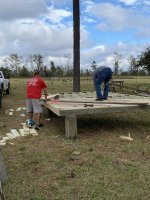I've finally gotten around to starting on the cabin/bunkhouse I have planned for the last five years. I want to make it as comfortable and livable as possible, without spending outrageous money.
It is actually on the backside of the property we live on. In a secluded, very quiet spot. I intend to install a tankless propane water heater, to facilitate hot showers. There is a water line within 150 yards running to a cattle tank, so I will just need 400-500 ft of pvc to get water there. Will also have a flush toilet. I intend to install a small, vented wall mounted propane heater.
My main question is about electric. I have four Honda gensets , ranging from 1000 to 8500 watt. I don't really want to use the big one, because it is very loud. The 2800 watt unit would provide ample power, including a 5000 BTU window unit AC. No tv, no electric appliances, except for a coffee maker. Really, lights and the AC would be about all. No tv, etc. possibly a fan or two.
I'm wondering about the feasibility of a battery bank system, kept charged up by a generator. I'm envisioning running the generator during the week, before expected weekend visitors, to charge the batteries. I'm not knowledgeable enough to know if the AC would be too much of a load to make that practical. Could possibly keep the generator in reserve for powering the AC, and use the batterys for lights. If anyone has been there and done that, I would appreciate suggestions.
Probably, just the generator(s) is the way I will go. The cabin would mostly be used on weekends, providing comfortable sleeping quarters for visiting relatives and daughter's in-laws.
There will be 240 sq ft of living area, two 10x12 rooms, with a sleeping loft. That area heated and cooled. Another 200-300 sq ft in porch off the front, and shed off the back. Insulated.
I'm building with the help of a couple of part-timers, a retired police officer, and a part time maintenance guy in a housing project. Ninety percent of the lumber was grown, cut, and milled on the farm. The two guys really turn out the work. In four 1/2 days, maybe 20 hours, they got the floor framed and sub-floored with 1 inch pine boards, got the roof trusses laid out, built and stockpiled, and have one wall nearly ready to stand up.
It is actually on the backside of the property we live on. In a secluded, very quiet spot. I intend to install a tankless propane water heater, to facilitate hot showers. There is a water line within 150 yards running to a cattle tank, so I will just need 400-500 ft of pvc to get water there. Will also have a flush toilet. I intend to install a small, vented wall mounted propane heater.
My main question is about electric. I have four Honda gensets , ranging from 1000 to 8500 watt. I don't really want to use the big one, because it is very loud. The 2800 watt unit would provide ample power, including a 5000 BTU window unit AC. No tv, no electric appliances, except for a coffee maker. Really, lights and the AC would be about all. No tv, etc. possibly a fan or two.
I'm wondering about the feasibility of a battery bank system, kept charged up by a generator. I'm envisioning running the generator during the week, before expected weekend visitors, to charge the batteries. I'm not knowledgeable enough to know if the AC would be too much of a load to make that practical. Could possibly keep the generator in reserve for powering the AC, and use the batterys for lights. If anyone has been there and done that, I would appreciate suggestions.
Probably, just the generator(s) is the way I will go. The cabin would mostly be used on weekends, providing comfortable sleeping quarters for visiting relatives and daughter's in-laws.
There will be 240 sq ft of living area, two 10x12 rooms, with a sleeping loft. That area heated and cooled. Another 200-300 sq ft in porch off the front, and shed off the back. Insulated.
I'm building with the help of a couple of part-timers, a retired police officer, and a part time maintenance guy in a housing project. Ninety percent of the lumber was grown, cut, and milled on the farm. The two guys really turn out the work. In four 1/2 days, maybe 20 hours, they got the floor framed and sub-floored with 1 inch pine boards, got the roof trusses laid out, built and stockpiled, and have one wall nearly ready to stand up.




